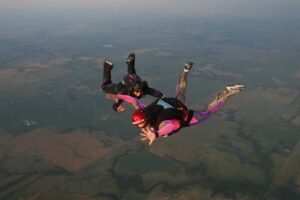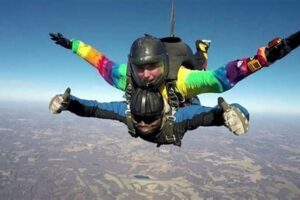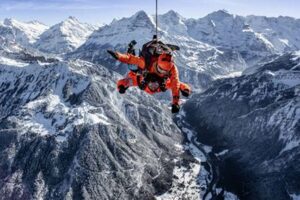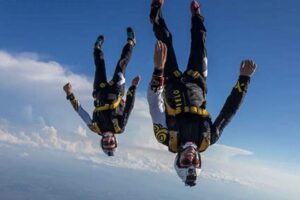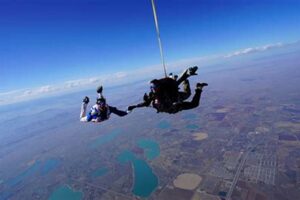Table of Contents
When Does a Skydiver Achieve Terminal Velocity? Unraveling the Physics of Freefall
Terminal velocity, the constant speed at which an object in freefall reaches a balance between the force of gravity and air resistance, is a captivating concept in physics. Imagine a skydiver leaping from an airplane, accelerating downwards until they attain terminal velocity. This fascinating phenomenon has practical implications in skydiving, aviation, and even space exploration.
Understanding terminal velocity is crucial for parachutists. By calculating the time it takes to reach terminal velocity, skydivers can plan their jumps accordingly, ensuring a safe and controlled descent. Moreover, this knowledge enables them to adjust their body position to minimize air resistance and achieve a desired descent rate. Historically, the study of terminal velocity dates back to Galileo’s groundbreaking experiments on falling objects, which laid the foundation for modern physics.
This article delves into the intricacies of terminal velocity, exploring the factors that influence its attainment, such as the skydiver’s weight, body position, and altitude. We will also investigate the applications of terminal velocity in various fields and uncover the intriguing history behind its discovery. Get ready for a thrilling journey into the world of physics and freefall.
When Does a Skydiver Achieve Terminal Velocity?
Understanding the essential aspects of terminal velocity is crucial for skydivers, engineers, and anyone interested in the physics of freefall. These aspects encompass various dimensions related to the conditions under which a skydiver achieves terminal velocity.
- Mass: The skydiver’s weight influences their acceleration due to gravity and, subsequently, their terminal velocity.
- Surface Area: A skydiver’s body position and the resulting surface area exposed to air resistance impact their terminal velocity.
- Air Density: The density of the air through which the skydiver falls affects the amount of air resistance encountered, influencing terminal velocity.
- Drag Coefficient: This coefficient represents the shape and orientation of the skydiver’s body, determining the amount of air resistance experienced.
- Gravity: The acceleration due to gravity is a constant factor that influences the skydiver’s acceleration and terminal velocity.
- Altitude: The height from which the skydiver jumps affects the air density and, consequently, the terminal velocity.
- Equipment: The type of parachute, suit, and other gear used by the skydiver can alter their overall mass and surface area, influencing terminal velocity.
- Wind Speed: Tailwinds or headwinds can alter the skydiver’s horizontal velocity, affecting their overall descent rate and terminal velocity.
- Body Position: The skydiver’s body position, such as a spread-eagle or streamlined posture, directly affects the surface area and drag coefficient, impacting terminal velocity.
These key aspects collectively determine the point at which a skydiver transitions from accelerating due to gravity to reaching a constant terminal velocity. Understanding these factors enables skydivers to optimize their freefall experience, ensuring a safe and controlled descent.
Mass
The relationship between a skydiver’s mass and their terminal velocity is a crucial aspect of understanding the physics of freefall. Mass, which is a measure of an object’s resistance to acceleration, directly influences the acceleration experienced by a skydiver due to gravity. Consequently, it plays a significant role in determining when the skydiver achieves terminal velocity.
According to Newton’s second law of motion, the acceleration of an object is directly proportional to the net force acting on it and inversely proportional to its mass. In the case of a skydiver, the net force acting on them is the force of gravity pulling them downwards and the force of air resistance pushing them upwards. As the skydiver falls, air resistance increases due to their increasing velocity. Eventually, a point is reached where the force of air resistance becomes equal to the force of gravity, resulting in a constant velocity known as terminal velocity.
A heavier skydiver experiences a greater force of gravity compared to a lighter skydiver. This means that the heavier skydiver will accelerate downwards more rapidly. Consequently, they will reach a higher terminal velocity than a lighter skydiver. This is because the heavier skydiver will encounter more air resistance as they fall faster, which will eventually balance out the force of gravity and result in a constant terminal velocity.
Real-life examples illustrate the connection between mass and terminal velocity. Heavier skydivers, such as those carrying additional gear or equipment, will reach a higher terminal velocity compared to lighter skydivers. This is a crucial consideration in skydiving, as skydivers need to be aware of their terminal velocity to ensure a safe and controlled descent. Understanding this relationship allows skydivers to adjust their body position and deployment altitude to achieve the desired terminal velocity.
The practical applications of understanding the relationship between mass and terminal velocity extend beyond skydiving. It is essential in various fields, including aviation, engineering, and space exploration. By considering the mass of an object and the air resistance it encounters, engineers can design aircraft, rockets, and other vehicles to achieve optimal performance and efficiency.
In summary, the mass of a skydiver significantly influences their acceleration due to gravity and, subsequently, their terminal velocity. Heavier skydivers reach a higher terminal velocity compared to lighter skydivers. Understanding this relationship is crucial for skydivers to ensure a safe and controlled descent. Moreover, it has practical applications in various fields, enabling engineers to design vehicles that can navigate through the air or space effectively.
Surface Area
Within the broader context of understanding when a skydiver achieves terminal velocity, the aspect of surface area holds significant relevance. It encompasses the skydiver’s body position and the resulting surface area exposed to air resistance, which collectively influence the rate of descent and the point at which terminal velocity is reached.
- Body Position: The skydiver’s posture and orientation in freefall directly affect the surface area exposed to air resistance. A spread-eagle position, for instance, creates a larger surface area compared to a streamlined, head-down position. This variation in surface area impacts the amount of air resistance encountered and, consequently, the terminal velocity.
- Equipment: The type of equipment used by the skydiver, including the parachute, suit, and helmet, can alter the overall surface area of the skydiver. A larger surface area due to specialized equipment will lead to increased air resistance and a lower terminal velocity.
- Altitude: The altitude from which the skydiver jumps influences the air density. As the skydiver descends, the air density increases, resulting in greater air resistance. T
his increase in air resistance affects the terminal velocity, causing it to decrease as the skydiver approaches the ground. - Drag Coefficient: The drag coefficient is a dimensionless number that quantifies the resistance of an object moving through a fluid. In skydiving, the drag coefficient depends on the skydiver’s body position and equipment. A lower drag coefficient indicates a more streamlined body position, which reduces air resistance and allows for a higher terminal velocity.
These facets collectively contribute to understanding when a skydiver achieves terminal velocity. By manipulating their body position, selecting appropriate equipment, considering the jump altitude, and minimizing the drag coefficient, skydivers can influence their terminal velocity to achieve a safe and controlled descent.
Air Density
Air density plays a crucial role in determining when a skydiver achieves terminal velocity. As a skydiver falls, they encounter air resistance, which is a force that opposes their motion. The denser the air, the greater the air resistance. This is because there are more air particles for the skydiver to collide with, which slows them down.
The relationship between air density and terminal velocity is inversely proportional. This means that as air density increases, terminal velocity decreases. Conversely, as air density decreases, terminal velocity increases. This is because the force of air resistance is proportional to the square of the velocity. Therefore, a small increase in velocity results in a significant increase in air resistance.
Real-life examples illustrate the impact of air density on terminal velocity. Skydivers jumping from higher altitudes experience lower air density and, consequently, achieve a higher terminal velocity compared to skydivers jumping from lower altitudes. Similarly, skydivers jumping in cold weather experience higher air density and, therefore, reach a lower terminal velocity compared to skydivers jumping in warm weather.
Understanding the relationship between air density and terminal velocity has practical applications in skydiving. By considering the air density at different altitudes and temperatures, skydivers can adjust their body position and deployment altitude to achieve the desired terminal velocity. This ensures a safe and controlled descent.
In summary, air density is a critical factor that influences when a skydiver achieves terminal velocity. The denser the air, the lower the terminal velocity. This understanding is essential for skydivers to ensure a safe and controlled descent.
Drag Coefficient
Within the context of understanding when a skydiver achieves terminal velocity, the drag coefficient holds significant importance. It quantifies the air resistance encountered by the skydiver, which in turn influences their terminal velocity. A lower drag coefficient indicates a more streamlined body position, resulting in less air resistance and a higher terminal velocity. Conversely, a higher drag coefficient indicates a less streamlined body position, leading to more air resistance and a lower terminal velocity.
- Body Position: The skydiver’s body position plays a crucial role in determining the drag coefficient. A streamlined, head-down position reduces the surface area exposed to air resistance, resulting in a lower drag coefficient. In contrast, a spread-eagle position increases the surface area and, consequently, the drag coefficient.
- Equipment: The type of equipment used by the skydiver, including the parachute, suit, and helmet, can affect the drag coefficient. Specialized equipment designed for skydiving often incorporates features that reduce the drag coefficient, allowing for a higher terminal velocity.
- Altitude: The altitude at which the skydiver jumps influences the air density. As the skydiver descends, the air density increases, resulting in a higher drag coefficient and a lower terminal velocity. This is because there are more air particles for the skydiver to collide with at lower altitudes.
- Wind Speed: The wind speed and direction can also affect the drag coefficient. A headwind increases the drag coefficient and reduces the terminal velocity, while a tailwind decreases the drag coefficient and increases the terminal velocity.
In summary, the drag coefficient is a crucial factor that influences when a skydiver achieves terminal velocity. By understanding the components and implications of the drag coefficient, skydivers can optimize their body position, equipment, and jump altitude to achieve the desired terminal velocity for a safe and controlled descent.
Gravity
Gravity, the force that attracts objects towards each other, plays a crucial role in determining when a skydiver achieves terminal velocity. As a skydiver falls, the force of gravity pulls them downwards, causing them to accelerate. The acceleration due to gravity is constant, approximately 9.8 m/s, regardless of the skydiver’s mass or velocity.
The relationship between gravity and terminal velocity is inversely proportional. As gravity increases, terminal velocity decreases. This is because the force of gravity counteracts the force of air resistance, which is the upward force that opposes the skydiver’s motion. As the skydiver falls, air resistance increases due to their increasing velocity. Eventually, a point is reached where the force of air resistance becomes equal to the force of gravity, resulting in a constant velocity known as terminal velocity.
Real-life examples illustrate the connection between gravity and terminal velocity. Skydivers jumping from higher altitudes experience a longer period of freefall and, consequently, achieve a higher terminal velocity compared to skydivers jumping from lower altitudes. This is because they have more time to accelerate due to gravity before reaching terminal velocity.
Understanding the relationship between gravity and terminal velocity has practical applications in skydiving. By considering the altitude from which they jump and the expected terminal velocity, skydivers can adjust their body position and deployment altitude to achieve a safe and controlled descent.
In summary, gravity is a fundamental factor that influences when a skydiver achieves terminal velocity. Gravity provides the acceleration that causes the skydiver to fall, and its constant value determines the rate at which the skydiver accelerates. Understanding this relationship is crucial for skydivers to ensure a safe and controlled descent.
Altitude
Within the broader context of understanding when a skydiver achieves terminal velocity, the aspect of altitude plays a crucial role. Altitude influences the air density, which in turn affects the amount of air resistance encountered by the skydiver. This intricate relationship between altitude, air density, and terminal velocity is a fundamental concept in skydiving.
- Air Density Variation: As a skydiver jumps from a higher altitude, the air density decreases. This is because the air is thinner at higher altitudes, resulting in fewer air particles per unit volume. The decrease in air density leads to a reduction in air resistance.
- Terminal Velocity and Altitude: The lower air density at higher altitudes results in a higher terminal velocity. This is because the force of air resistance is proportional to the square of the velocity. Therefore, a small decrease in air density leads to a significant decrease in air resistance, allowing the skydiver to accelerate to a higher terminal velocity.
- Real-Life Examples: Skydivers jumping from higher altitudes, such as 15,000 feet, typically reach terminal velocities in the range of 120 to 130 miles per hour. In contrast, skydivers jumping from lower altitudes, such as 5,000 feet, may only reach terminal velocities around 90 to 100 miles per hour.
- Implications for Skydiver
s: Understanding the relationship between altitude and terminal velocity is crucial for skydivers. They can adjust their jump altitude and body position to achieve a desired terminal velocity, ensuring a safe and controlled descent.
In conclusion, the aspect of altitude significantly influences when a skydiver achieves terminal velocity. The lower air density at higher altitudes leads to a higher terminal velocity. Skydivers consider this relationship to optimize their jumps and ensure a safe and controlled descent.
Equipment
The equipment used by a skydiver plays a pivotal role in determining when they achieve terminal velocity. This relationship is rooted in the fundamental principles of physics that govern the forces acting on a skydiver during freefall.
Cause and Effect:
- Mass and Terminal Velocity: The mass of the skydiver, including their gear, directly influences their terminal velocity. A heavier skydiver experiences a greater force of gravity, leading to a higher acceleration and, consequently, a higher terminal velocity.
- Surface Area and Air Resistance: The surface area of the skydiver, affected by their body position and equipment, impacts air resistance. A larger surface area encountering air resistance slows down the skydiver, resulting in a lower terminal velocity.
Importance as a Component:
Understanding the connection between equipment and terminal velocity is critical for skydivers to ensure a safe and controlled descent. By carefully selecting their equipment, skydivers can manipulate their mass and surface area to achieve a desired terminal velocity.
Real-Life Examples:
- Parachute Deployment: Skydivers adjust the timing of their parachute deployment to control their terminal velocity. Deploying the parachute at a higher altitude and allowing more time for freefall leads to a higher terminal velocity, providing a thrilling experience for skilled skydivers.
- Wingsuits: Specially designed wingsuits increase the surface area of the skydiver, generating more lift and allowing for controlled flight. This advanced technique enables skydivers to achieve terminal velocities close to 100 miles per hour.
Practical Applications:
Beyond skydiving, the understanding of equipment’s impact on terminal velocity has broader applications:
- Aviation: Engineers design aircraft wings to optimize airflow and achieve desired flight characteristics, including terminal velocity.
- Space Exploration: Scientists consider the mass and surface area of spacecraft when calculating their terminal velocity during atmospheric entry, ensuring a controlled landing.
Conclusion:
In conclusion, the equipment used by a skydiver, encompassing mass and surface area factors, plays a crucial role in determining when they achieve terminal velocity. Understanding this relationship is essential for skydivers to ensure a safe and controlled descent, while also extending applications to various fields, including aviation and space exploration.
Wind Speed
The relationship between wind speed and a skydiver’s terminal velocity is a crucial aspect of understanding the physics of freefall. Wind speed, whether a tailwind or a headwind, directly influences the skydiver’s horizontal velocity, which in turn affects their overall descent rate and the point at which they achieve terminal velocity.
A tailwind, blowing in the same direction as the skydiver’s descent, increases their horizontal velocity. This increased horizontal velocity results in a lower vertical descent rate and a higher overall groundspeed. Consequently, the skydiver takes longer to reach terminal velocity as their downward motion is counteracted by the tailwind.
Conversely, a headwind, blowing in the opposite direction of the skydiver’s descent, decreases their horizontal velocity. This reduced horizontal velocity leads to a higher vertical descent rate and a lower overall groundspeed. As a result, the skydiver reaches terminal velocity more quickly as the headwind assists their downward motion.
Real-life examples illustrate the impact of wind speed on terminal velocity. Skydivers jumping in windy conditions often experience significant variations in their descent rate and the altitude at which they achieve terminal velocity. For instance, a skydiver jumping with a strong tailwind may take several seconds longer to reach terminal velocity compared to a skydiver jumping in calm conditions.
Understanding the relationship between wind speed and terminal velocity is essential for skydivers to ensure a safe and controlled descent. By considering the wind conditions and adjusting their body position and deployment altitude, skydivers can optimize their descent rate and achieve the desired terminal velocity for a safe landing.
Beyond skydiving, the understanding of wind speed’s impact on terminal velocity finds applications in various fields. In aviation, pilots consider wind speed when calculating takeoff and landing speeds, ensuring efficient and safe flight operations. Similarly, in space exploration, scientists account for wind speed when designing spacecraft trajectories during atmospheric entry and landing procedures.
In conclusion, wind speed, whether a tailwind or a headwind, plays a significant role in determining when a skydiver achieves terminal velocity. Understanding this relationship is crucial for skydivers to optimize their descents and for professionals in various fields to design and operate vehicles efficiently and safely in windy conditions.
Body Position
The connection between body position and terminal velocity in skydiving is a crucial aspect of understanding the physics of freefall. A skydiver’s body position significantly influences when they achieve terminal velocity, the constant speed at which air resistance balances the force of gravity.
Cause and Effect:
- Surface Area and Drag Coefficient: The skydiver’s body position directly affects their surface area exposed to air resistance and the drag coefficient.
- Spread-Eagle vs. Streamlined: A spread-eagle posture increases surface area and drag, while a streamlined posture reduces both.
- Impact on Terminal Velocity: Increased surface area and drag slow down the skydiver, delaying the achievement of terminal velocity, while a streamlined posture facilitates a faster attainment of terminal velocity.
Importance as a Component of “When Does a Skydiver Achieve Terminal Velocity”:
- Critical Factor: Body position is a critical component in determining when a skydiver achieves terminal velocity.
- Control and Safety: Understanding the relationship between body position and terminal velocity allows skydivers to control their descent rate and ensure a safe landing.
Real-Life Examples:
- Beginners vs. Experienced Skydivers: Beginners often adopt a spread-eagle position, resulting in a lower terminal velocity and a more gradual descent. Experienced skydivers use a streamlined posture, achieving a higher terminal velocity for a faster descent.
- Body Position Adjustments: During freefall, skydivers adjust their body position to control their descent rate. For instance, they may spread their arms and legs to slow down or tuck in their limbs to accelerate.
Practical Applications:
- Skydiving: Body position is crucial for skydivers to control their descent and perform maneuvers.
- Aviation: Understanding body position’s impact on terminal velocity is essential in designing aircraft and calculating their flight characteristics.
- Space Exploration: Astronauts use body
position to control their descent during spacewalks and atmospheric entries.
Summary of Insights:
- Body position significantly influences terminal velocity by affecting surface area and drag coefficient.
- Understanding this relationship is crucial for skydivers to control their descent and ensure safety.
- The principles apply to various fields, including aviation and space exploration.
In conclusion, body position is an integral aspect of understanding when a skydiver achieves terminal velocity. By manipulating their body position, skydivers can optimize their descent rate and achieve a safe and controlled landing. Furthermore, this understanding has practical applications in aviation and space exploration, highlighting the importance of physics in various fields.
Frequently Asked Questions
This section addresses common queries and misconceptions regarding the topic of when a skydiver achieves terminal velocity. These questions aim to clarify various aspects of the physics involved and provide a deeper understanding of this phenomenon.
Question 1: What exactly is terminal velocity, and how does it relate to skydiving?
Answer: Terminal velocity is the constant speed reached by an object in freefall when the force of gravity pulling it downwards is balanced by the force of air resistance pushing it upwards. In skydiving, this is the speed at which a skydiver’s descent stabilizes.
Question 2: What factors influence when a skydiver achieves terminal velocity?
Answer: Several factors affect the point at which a skydiver reaches terminal velocity, including their mass, surface area, body position, air density, and wind speed. These factors determine the amount of air resistance encountered during freefall.
Question 3: How does a skydiver’s mass impact their terminal velocity?
Answer: A skydiver’s mass is directly proportional to the force of gravity acting on them. Heavier skydivers experience a greater gravitational pull, leading to a higher terminal velocity.
Question 4: Why does body position influence the achievement of terminal velocity?
Answer: Body position affects the skydiver’s surface area and drag coefficient. A spread-eagle posture increases both, resulting in more air resistance and a lower terminal velocity. Conversely, a streamlined posture reduces surface area and drag, allowing for a higher terminal velocity.
Question 5: How does air density affect terminal velocity?
Answer: Air density is inversely proportional to terminal velocity. As air density increases, such as at lower altitudes, air resistance increases, and terminal velocity decreases. Conversely, at higher altitudes where air density is lower, terminal velocity is higher.
Question 6: Can wind speed affect when a skydiver reaches terminal velocity?
Answer: Yes, wind speed can influence terminal velocity. A tailwind, blowing in the same direction as the skydiver’s descent, increases their horizontal velocity and slows their vertical descent. This can delay the achievement of terminal velocity. Conversely, a headwind has the opposite effect, causing the skydiver to reach terminal velocity more quickly.
In summary, the achievement of terminal velocity in skydiving is influenced by various factors related to the skydiver and the environment. Understanding these factors allows skydivers to control their descent rate and ensure a safe and enjoyable experience.
In the next section, we will delve deeper into the practical applications of terminal velocity in skydiving and explore how skydivers manipulate their body position and equipment to achieve a desired terminal velocity for a controlled descent.
Tips for Achieving a Controlled and Safe Descent
This section provides essential tips to help skydivers achieve a controlled and safe descent by optimizing their body position and equipment.
Tip 1: Master the Streamlined Position:
Adopt a streamlined body position with your arms close to your sides, legs extended, and toes pointed. This reduces surface area and drag, allowing for a higher terminal velocity and a more stable descent.
Tip 2: Adjust Your Body Angle:
Fine-tune your body angle to control your descent rate. Tilting your body slightly forward increases your speed, while tilting backward slows you down. Experiment with different angles to find the optimal position for your desired descent rate.
Tip 3: Maintain Proper Weight Distribution:
Ensure your weight is evenly distributed throughout your body. Avoid shifting your weight to one side or the other, as this can cause instability and affect your terminal velocity.
Tip 4: Use Equipment to Your Advantage:
Choose equipment that suits your skill level and flying style. A properly fitted jumpsuit and helmet can reduce drag, while a high-performance parachute can provide better control during descent.
Tip 5: Practice and Seek Guidance:
Regular practice and guidance from experienced instructors are invaluable in developing the skills and techniques necessary for a controlled descent. Attend skydiving courses, workshops, and coaching sessions to improve your understanding and execution.
Key Takeaways:
By mastering the streamlined position, adjusting body angle, maintaining proper weight distribution, using appropriate equipment, and continuously practicing, skydivers can achieve a controlled and safe descent, maximizing their enjoyment of the sport.
These tips lay the foundation for the concluding section, which delves into the exhilarating experiences and personal growth opportunities that skydiving offers to those who embrace the challenges of freefall.
Conclusion
This comprehensive exploration of “when does a skydiver achieve terminal velocity” unveils a captivating interplay of physics, human skill, and the thrill of freefall. Several key ideas emerge, illuminating the intricate relationship between skydivers and their environment.
- Factors Influencing Terminal Velocity: Terminal velocity in skydiving is influenced by a multitude of factors, including the skydiver’s mass, surface area, body position, air density, and wind speed. Understanding these factors allows skydivers to predict and control their descent rate, ensuring a safe and enjoyable experience.
- Body Position and Equipment: Skydivers can manipulate their body position and equipment to achieve a desired terminal velocity. A streamlined body position reduces drag and increases terminal velocity, while a spread-eagle position increases drag and slows the descent. Additionally, specialized equipment like wingsuits and high-performance parachutes can further enhance the skydiver’s control over their descent.
- Control and Safety: Understanding the factors that influence terminal velocity is paramount for skydivers’ safety. By carefully considering their body position, equipment, and environmental conditions, skydivers can maintain a controlled descent, minimizing risks and maximizing their enjoyment of the sport.
The exploration of “when does a skydiver achieve terminal velocity” highlights the fascinating interplay between physics and human ingenuity in the realm of skydiving. It underscores the importance of understanding the forces that govern freefall and the techniques skydivers employ to navigate them. As the sport continues to evolve, future advancements in equipment and training methods promise even greater control and safety for skydivers, allowing them to push the boundaries of human flig
ht.


